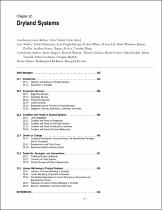JavaScript is disabled for your browser. Some features of this site may not work without it.
- ResearchSpace
- →
- Research Publications/Outputs
- →
- Book Chapters
- →
- View Item
| dc.contributor.author |
Wessels, Konrad J

|
|
| dc.date.accessioned | 2007-08-23T12:39:34Z | |
| dc.date.available | 2007-08-23T12:39:34Z | |
| dc.date.issued | 2006 | |
| dc.identifier.citation | Wessels, KJ. 2006. Dryland systems. Ecosystems and human well-being: current state and trends. Chapter 22, Island Press, pp 623-662. | en |
| dc.identifier.uri | http://hdl.handle.net/10204/1158 | |
| dc.description.abstract | This chapter describes the current condition of dryland systems with respect to the services they provide and the drivers that determine trends in their provision. Within the context of the mounting global concern caused by land degradation in drylands (defined as desertification in the text of the United Nations Convention to Combat Desertification), the chapter assesses deserti- fication as a persistent reduction in the services provided by dryland ecosystems, leading to unsustainable use of the drylands and their impaired development. The chapter also explores options for the sustainable use of drylands and points to human and societal responses that have succeeded or failed. ‘‘Desertification’’ means land degradation in arid, semiarid, and dry subhumid areas resulting from various factors, including climatic variations and human activities. Land degradation means reduction of or loss in the biological or economic productivity and complexity of rain-fed cropland, irrigated cropland, range, pasture, forest, or woodlands resulting from land uses or from processes arising from human activities and habitation patterns (UNCCD 1992). Though this definition excludes the hyper-arid drylands, this chapter explores land degradation in all global drylands,including the hyper-arid areas. | en |
| dc.language.iso | en | en |
| dc.subject | Dryland systems | en |
| dc.subject | Land degradation | en |
| dc.subject | Ecosystems | en |
| dc.subject | Drylands | en |
| dc.title | Dryland systems | en |
| dc.type | Book Chapter | en |
| dc.identifier.apacitation | Wessels, K. J. (2006). Dryland systems., <i></i> http://hdl.handle.net/10204/1158 | en_ZA |
| dc.identifier.chicagocitation | Wessels, Konrad J. "Dryland systems" In <i></i>, n.p.: n.p. 2006. http://hdl.handle.net/10204/1158. | en_ZA |
| dc.identifier.vancouvercitation | Wessels KJ. Dryland systems. [place unknown]: [publisher unknown]; 2006. [cited yyyy month dd]. http://hdl.handle.net/10204/1158. | en_ZA |
| dc.identifier.ris | TY - Book Chapter AU - Wessels, Konrad J AB - This chapter describes the current condition of dryland systems with respect to the services they provide and the drivers that determine trends in their provision. Within the context of the mounting global concern caused by land degradation in drylands (defined as desertification in the text of the United Nations Convention to Combat Desertification), the chapter assesses deserti- fication as a persistent reduction in the services provided by dryland ecosystems, leading to unsustainable use of the drylands and their impaired development. The chapter also explores options for the sustainable use of drylands and points to human and societal responses that have succeeded or failed. ‘‘Desertification’’ means land degradation in arid, semiarid, and dry subhumid areas resulting from various factors, including climatic variations and human activities. Land degradation means reduction of or loss in the biological or economic productivity and complexity of rain-fed cropland, irrigated cropland, range, pasture, forest, or woodlands resulting from land uses or from processes arising from human activities and habitation patterns (UNCCD 1992). Though this definition excludes the hyper-arid drylands, this chapter explores land degradation in all global drylands,including the hyper-arid areas. DA - 2006 DB - ResearchSpace DP - CSIR KW - Dryland systems KW - Land degradation KW - Ecosystems KW - Drylands LK - https://researchspace.csir.co.za PY - 2006 T1 - Dryland systems TI - Dryland systems UR - http://hdl.handle.net/10204/1158 ER - | en_ZA |






